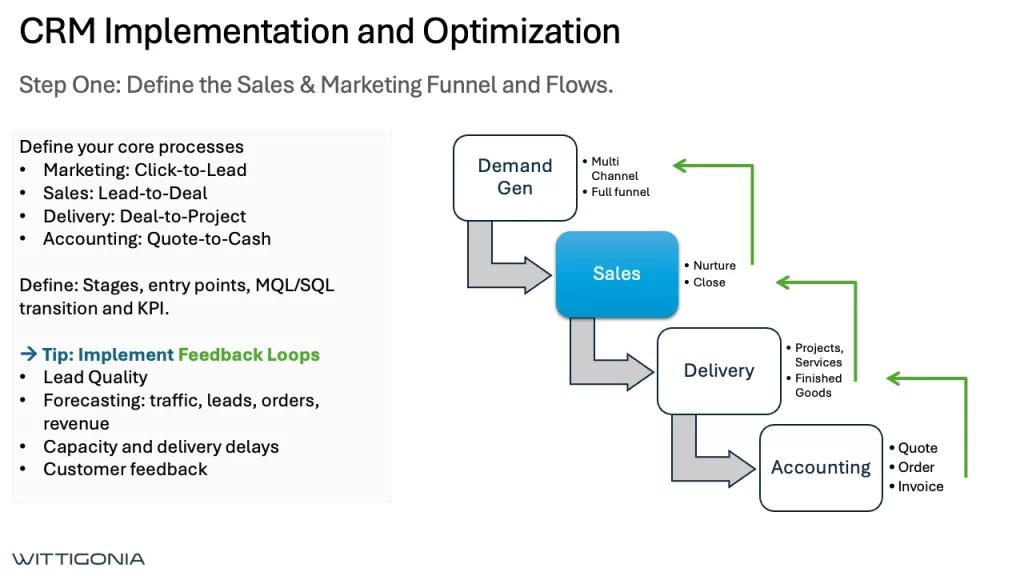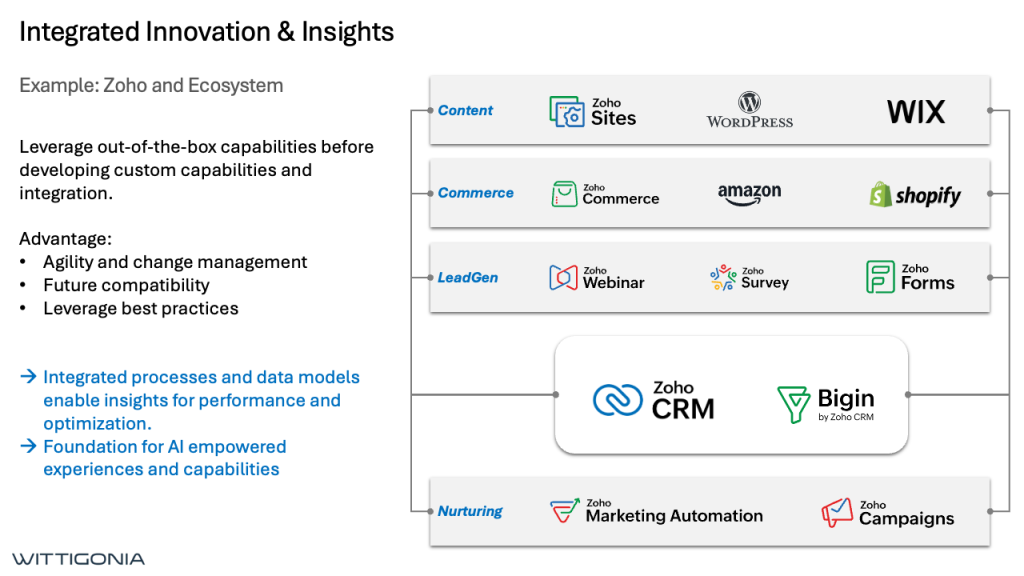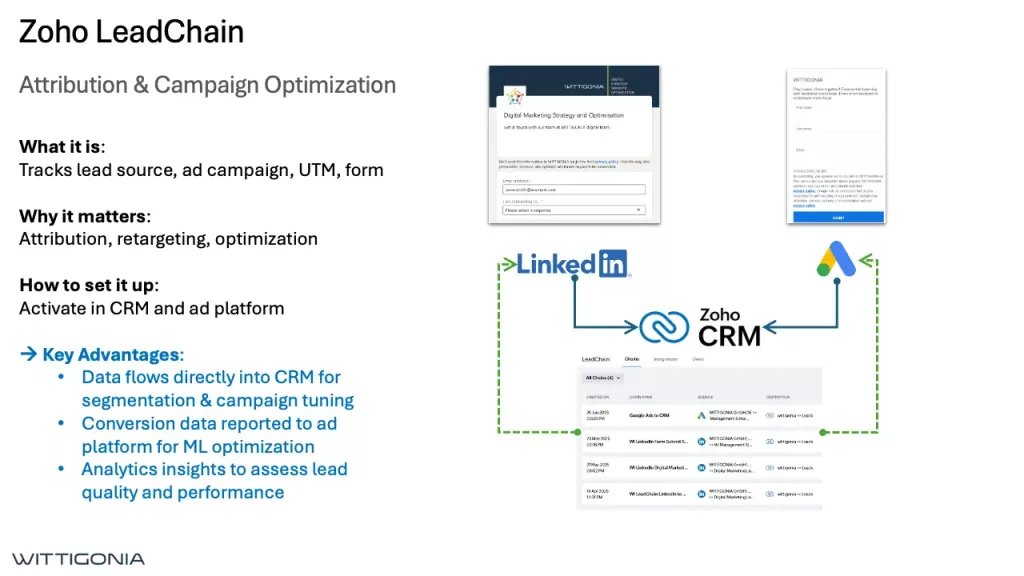Zoho CRM Implemented? Check! What Now? – Getting More Out of Your Zoho One Tool Stack
So you have implemented Zoho CRM. Congratulations! Good choice. A powerful foundation. The technical setup is complete, your data is migrated, and your team has received training. But here is the reality I see with most organizations: they have great tools but struggle to gain real traction.
Sound familiar? You are not alone. After working with companies on their digital transformation journeys, I have noticed a pattern. The technical implementation is often the easy part. The real challenge begins when you ask: “Now what? How do we actually get more out of this system?”. And often the question is: “How do we get more (leads) into the system?“
Let me share what we have learned about turning Zoho One – and specifically Zoho CRM at the heart of it – from a fancy contact database into a genuine growth engine. What I am about to share can be applicable to other CRM and marketing automation solutions as well.
Before we dive into the specific strategies, watch this 15-minute presentation where I walk through the exact framework we use with clients to optimize their Zoho CRM implementations:
In this presentation, I cover the common pitfalls, the “positive friction” concept, and practical steps for turning your CRM into an integrated sales and marketing engine.
Now, let’s explore each of these concepts in detail…
The Great Tools, No Traction Problem
I was talking to a client last week who summed it up perfectly: “We spent months implementing our new CRM, trained everyone, migrated all our data… and somehow we are still managing leads in spreadsheets.”
This happens more often than you might think. Organizations invest in powerful tools like Zoho CRM but fall into familiar patterns that prevent them from realizing the full potential of their investment.
The Spreadsheet Mentality Trap
Here is the thing many people miss: a CRM is not a spreadsheet. It is not just a tool. It is not even just a system. When implemented correctly, your Zoho CRM becomes the central nervous system of your business operations.
But old habits die hard. Teams continue thinking in rows and columns instead of processes and workflows. They treat the CRM like a digital filing cabinet rather than an active business intelligence platform.
Why CRM Projects Stagnate (And How to Fix It)
After analyzing hundreds of implementations, I have identified the core issues that prevent organizations from achieving CRM success:
Lack of Defined Processes
Most companies jump into CRM configuration without clearly defining their business processes. It is like building a house without blueprints. You end up with something functional, but it does not serve your actual needs.
I always ask clients: “Do you remember when you moved into your new house? After you moved in, you realize what you really would have wanted, right?” Many people can relate to that. The point is, that you should plan first before you move in. The same goes for your CRM implementation and migration.
Missing Feedback Loops
Traditional business operations often lack systematic feedback mechanisms. Your marketing team runs campaigns, sales follows up on leads, delivery fulfills orders, and accounting sends invoices. But where is the learning loop? How does information about lead quality flow back to marketing? As long as the marketing does not hear anything, they keep shovelling leads into the system. And how do delivery delays inform sales people and projections? It is painful to lose a client project because you can’t deliver in time.
So, set up the feedback loops. Simply establish a “Rhythm of the Busines” with regular synch-up meetings. Bonus Tip: No presentation allow – the data is already in the system. This supports adoption of the system and adherence to the process.
Privacy and Consent Confusion
With GDPR and other increasing privacy regulations, many organizations struggle with consent management. They either avoid collecting data entirely or import existing databases without proper consent frameworks. Both approaches limit growth potential. You can’t use data without consent. Even more problematic: The ad platforms such as Google Ads require consented data flows into the system.
Step One: Define Your Funnel and Create Flow
Before diving into Zoho marketing automation or complex workflows, you need to map your actual business process. Here is how I approach this with clients:
The Four-Stage Business Flow
Think of your business as a connected system with four critical stages:
- Demand Generation: Multi-channel marketing that creates awareness and captures interest
- Sales Process: Lead nurturing, qualification, and conversion activities
- Delivery Execution: Project fulfillment, service delivery, and customer satisfaction
- Financial Management: Quoting, ordering, invoicing, and revenue recognition
Each stage should feed information to the next while providing feedback to previous stages. This creates what I call “positive friction” – when marketing success creates good problems for sales, sales success creates good problems for delivery, and so on.
Implementing Strategic Feedback Loops
Smart organizations build feedback mechanisms into their processes from day one:
- Lead Quality Reporting: Regular analysis of which sources generate the best customers
- Capacity Planning: Understanding how marketing success impacts delivery capabilities
- Revenue Forecasting: Using historical data to predict future performance
- Customer Insights: Gathering feedback that informs product development and marketing messaging
It feels challenging and weird at the beginning. I have supported management teams as a “business review partner”. This can be a good start until it becomes a habit and second nature.

Leveraging What You Already Have: The Zoho Ecosystem Advantage
One of the biggest mistakes I see is organizations over-customizing before understanding what is available out-of-the-box. Zoho One provides a comprehensive suite of integrated tools that work together seamlessly.
Upstream Lead Generation Tools
Your lead generation toolkit is probably more comprehensive than you realize:
- Zoho Sites: For landing page creation and testing
- Zoho Forms: For lead capture and data collection
- Zoho Webinar: For engagement and qualification
- Zoho Survey: For customer research and feedback
Plus integrations with external platforms like LinkedIn Lead Generation Forms and Google Ads that feed directly into your CRM.
Downstream Marketing and Sales Automation
The real power emerges when you connect these tools into automated workflows:
- Zoho Marketing Automation: For sophisticated nurturing sequences
- Zoho Campaigns: For email marketing and communication
- Zoho CRM: As the central hub for all customer interactions

The Power of Tags, Workflows, and Scoring
Here is where many organizations miss opportunities. Zoho CRM includes powerful automation capabilities that most teams underutilize:
- Tagging Systems: Segment leads based on behavior, source, and interests
- Workflow Automation: Trigger actions based on specific criteria and events
- Lead Scoring: Prioritize prospects based on engagement and fit
The key is starting simple and building complexity gradually as your team adopts the processes.
Zoho LeadChain: The Attribution Game-Changer
Let me tell you about one feature that consistently surprises clients: Zoho LeadChain. This tool solves a problem that keeps marketing teams awake at night – attribution.
What LeadChain Actually Does for Sales Automation
LeadChain tracks the complete journey from ad click to CRM record. When someone clicks your Google Ads campaign and fills out a form, LeadChain captures:
- Campaign Information: Which specific campaign generated the lead
- Ad Group Details: The targeting and messaging that resonated
- Keyword Data: The search terms that triggered your ad
- UTM Parameters: Complete tracking for attribution analysis
Why This Matters for B2B Demand Generation
Most B2B sales cycles span weeks or months. Without proper attribution, you cannot determine which marketing investments actually drive revenue. LeadChain solves this by maintaining the connection between initial touchpoint and final conversion.
But here is the really clever part: LeadChain also sends conversion data back to advertising platforms. This enables machine learning algorithms to optimize for actual customers, not just form submissions.

Campaign Optimization: Patience and Testing
I need to share something that might disappoint you: good campaigns often underperform initially. I see this pattern constantly. Organizations launch carefully planned campaigns, see mediocre results in the first few weeks, and immediately start changing everything.
The Campaign Lifecycle Reality
Successful campaigns typically follow a predictable pattern:
- Traction Phase: Initial learning and audience building
- Efficiency Phase: Optimization of targeting and messaging
- Financial Phase: Sustainable cost-per-acquisition and ROAS
Most campaigns need 4-6 weeks to move through the traction phase. During this period, advertising platforms collect data, test creative variations, and refine targeting algorithms.
Avoiding the “Campaign of the Day” Trap
One of the biggest mistakes in digital marketing is constantly changing campaign strategies. I call this the “campaign of the day” mentality. Monday you are running LinkedIn campaigns, Tuesday you switch to Google Ads, Wednesday you try Facebook, and Thursday you wonder why nothing works.
Successful optimization requires consistency and systematic testing:
- Creative Testing: Headlines, images, and call-to-action variations
- Offer Optimization: Value propositions and incentive structures
- Audience Refinement: Demographic and behavioral targeting improvements
- Landing Page Enhancement: Conversion rate optimization and user experience
Privacy-Led Marketing: Building Trust and Compliance
Privacy regulations are not obstacles to growth – they are opportunities to build trust and create sustainable competitive advantages.
GDPR-Compliant Lead Generation
Effective consent management involves clear communication about data usage intentions. Instead of hiding privacy policies in fine print, make consent a value proposition.
Example approach: “We will send you our weekly insights about digital transformation trends. You can unsubscribe anytime, and we will never share your information with third parties.”
The Hidden Value in Consent-Based Marketing
When prospects voluntarily provide information and consent to communication, they demonstrate genuine interest. This self-selection creates higher-quality audiences for both internal nurturing and external retargeting campaigns.
Privacy-led marketing also enables sophisticated segmentation strategies:
- Communication Preferences: Email, phone, or survey-based outreach
- Content Interests: Industry insights, product updates, or educational resources
- Engagement Timing: Frequency and scheduling preferences
Extracting Hidden Value from Your Campaign Data
Most organizations collect campaign data but fail to extract actionable insights. Your Google Ads form extensions capture campaign names, ad groups, and keywords. Your LinkedIn campaigns provide industry and company size data. Your Zoho Forms track completion patterns and source attribution.
This information enables sophisticated lead routing and personalization strategies.
Cross-Functional Campaign Analysis
The real breakthrough happens when you review campaign performance across departments. Marketing sees click-through rates and cost-per-lead. Sales understands conversion quality and cycle length. Delivery observes project success rates and customer satisfaction.
When you combine these perspectives, patterns emerge that single-department analysis misses.
Implementing Your Integrated Sales and Marketing Engine
Based on everything I have shared, here are the practical steps for optimizing your Zoho CRM implementation:
Start with Process Definition
Before configuring workflows or automation, document your current processes. Map the customer journey from initial awareness through final delivery. Identify handoff points, decision criteria, and success metrics.
Leverage Out-of-the-Box Capabilities
Zoho provides extensive functionality that most organizations underutilize. Before building custom solutions, explore standard features in Zoho Marketing Automation, Zoho Campaigns, and Zoho CRM workflows.
Build Measurement Into Everything
Implement tracking and attribution from day one. Set up LeadChain integration, configure goal tracking, and establish regular reporting rhythms. The data you collect in the first month will inform optimization strategies for years.
Create Cross-Functional Feedback Loops
Schedule regular meetings between marketing, sales, delivery, and finance teams to review campaign performance, lead quality, and customer satisfaction. These sessions often reveal insights that individual department analysis overlooks.
The “Good Problems to Have” Philosophy
I want to leave you with a mindset shift that has transformed how my clients approach CRM optimization. Instead of trying to eliminate all friction, focus on creating positive friction.
Marketing should generate so many qualified leads that sales struggles to follow up quickly. Sales should close so many deals that delivery scrambles to fulfill orders. Delivery should create such satisfied customers that accounting cannot keep up with expansion revenue.
These are good problems to have. They indicate growth, success, and opportunity.
Your Zoho CRM implementation should create these positive challenges while providing the visibility and control needed to scale operations effectively.
Getting Started: Your Next Steps
If this resonates with your current CRM challenges, you have several options for moving forward:
- Audit Your Current Setup: Review your existing Zoho configuration against the principles outlined above
- Define Your Processes: Map your actual customer journey and identify optimization opportunities
- Implement Attribution Tracking: Set up LeadChain and comprehensive campaign measurement
- Create Feedback Systems: Establish regular cross-functional review processes
Remember, CRM optimization is not a destination – it is an ongoing process of measurement, learning, and improvement.
The WITTIGONIA Digital Growth Kickstart Kit and Zoho Marketing Services provide guidance and practical resources including funnel definition worksheets, marketing automation audit checklists, LeadChain setup guides, and example automation workflows. You can access these resources and book a strategy session at wittigonia.net/en/service/zoho-marketing.
About the Author
Thomas Wittig specializes in digital transformation, growth strategies and data-driven optimization that deliver measurable impact. With extensive experience in transformation and performance improvement projects, implementation, marketing automation optimization, and B2B demand generation, Thomas helps organizations transform their customer relationship management systems into integrated growth engines.
About WITTIGONIA
WITTIGONIA empowers businesses through strategic digital transformation and data-driven growth optimization. With our talents and partners, we specialize in digital empwerment and implemention such as Zoho One and related systems and tools.
Our expertise spans CRM optimization, privacy-compliant lead generation, campaign attribution modeling, and cross-functional process improvement. We help organizations build sustainable competitive advantages by transforming disconnected tools into integrated business systems.
Through strategic consulting, hands-on implementation support, and ongoing optimization services, WITTIGONIA ensures that your digital transformation initiatives deliver measurable results. Our approach emphasizes practical solutions, systematic measurement, and continuous improvement that scales with your business growth.
Whether you need Zoho One, Zoho CRM and marketing campaign optimization, marketing automation workflow design, or comprehensive digital transformation strategy, WITTIGONIA provides the expertise and guidance necessary to maximize your technology investments and achieve your growth objectives.
Book your discovery session with our team. We look forward discussing your requirements and opportunities.
For more tips like this follow us also on LinkedIn and YouTube. You can find us on popular platforms by searching for “wittigonia” or with our social handle @wittigonia.
